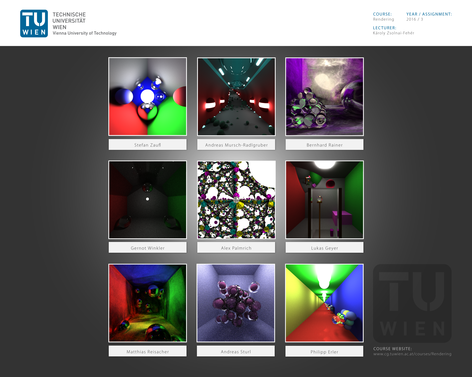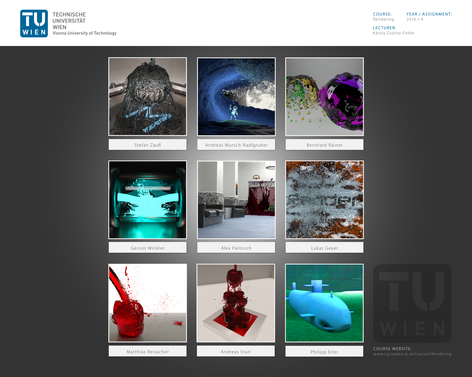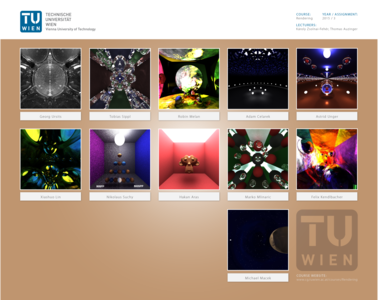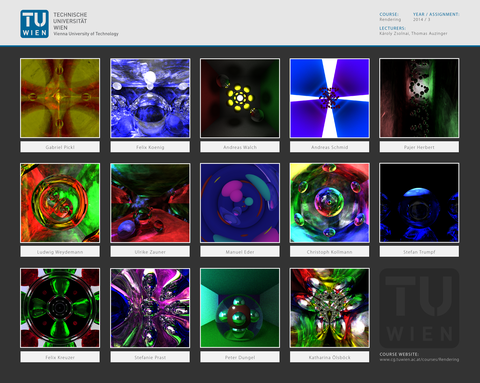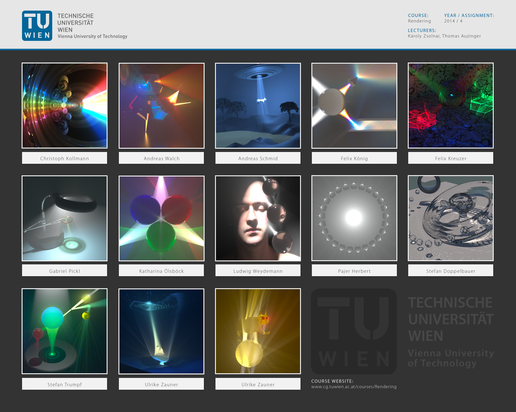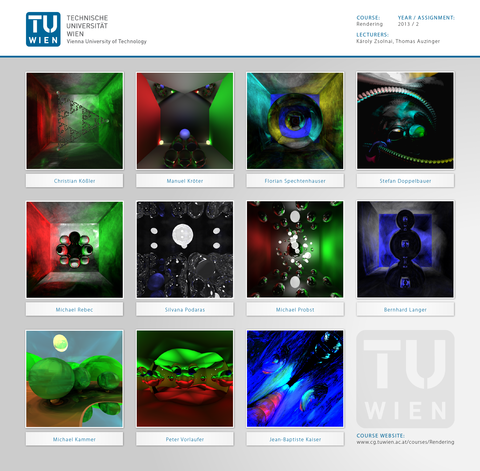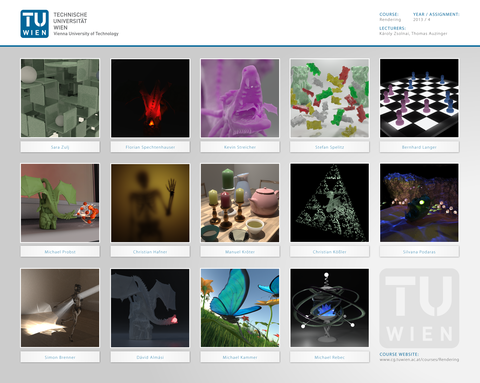Details
Registration and course data is available on the TISS site.The whole course is now available in video.
This year, the course will be given remotely. Details will be announced via a TISS message.
Please note that the lecture slides are continually improved. The lectures and website always have precedence over the videos.
Lecture announcements
The exams are going to take place at the end of July and will be announced around mid-July.Properties
- Semester hours: 2.0
- Credits: 3.0
- Type: VU Lecture and Exercise
Aim of the course
This course aims to give an overview of basic and state-of-the-art methods of rendering. Offline methods such as ray and path tracing, photon mapping and many other algorithms are introduced and various refinement are explained.
The basics of the involved physics, such as geometric optics, surface and media interaction with light and camera models are outlined.
The apparatus of Monte Carlo methods is introduced which is heavily used in several algorithms and its refinement in the form of stratified sampling and the Metropolis-Hastings method is explained.
At the end of the course students should be familiar with common techniques in rendering and find their way around the current state-of-the-art of the field. Furthermore the exercises should deepen the attendees' understanding of the basic principles of light transport and enable them to write a simple rendering program themselves.
Subject of the course
- Rendering theory
Basic optics, rendering equation, filtering - Rendering algorithms
Ray tracing, radiosity, (bi-directional) path tracing, Metropolis light transport, precomputed radiance transfer, (stochastic progressive) photon mapping, irradiance caching, path space regularization, vertex connection and merging - Acceleration techniques
Spatial hierarchies, sampling strategies, - Surface representations
BRDF models: Lambert, Phong, Oren-Nayar, Cook-Torrance, Ashikhmin-Shirley - Participating media
Scattering, volumetric photon mapping, photon beams - Higher dimensional effects
Motion blur, depth of field - Camera models
Pinhole, Perspective, Orthographic - Post processing
HDR, tone mapping
Subject to refinement.
Additional Information
Literature
-
Physically Based Rendering, Third Edition: From Theory To Implementation, M. Pharr and G. Humphreys, Homepage, ACM
The main book of the lecture (referred to as PBRT). - Course on Monte-Carlo Methods in Global Illumination, L. Szirmay-Kalos, Link
A free course scriptum that gives a detailed explanation of the mathematical foundations of Global Illumination.
Lecture slides
- Unit 01 - Introduction, Radiometry (Thomas Auzinger). Erratum: on slide 81, the unit of radiance is given as [W sr^-1 m^-1] - it should be [W sr^-1 m^-2].
- Unit 02 - The Rendering Equation and Ray Tracing (Károly Zsolnai-Fehér)
- Unit 03 - Global Illumination and Path Tracing (Károly Zsolnai-Fehér)
- Unit 04 - Part 01 - Spatial Acceleration Structures (Thomas Auzinger)
- Unit 04 - Part 02 - Tonemapping (Thomas Auzinger)
- Unit 05 - Part 01 - Participating Media (Thomas Auzinger)
- Unit 05 - Part 02 - Subsurface Scattering (Thomas Auzinger)
- Unit 06 - Smallpaint code walkthrough (Károly Zsolnai-Fehér)
- Unit 07 - State of the art in Global Illumination (Károly Zsolnai-Fehér)
- Bonus Unit - Blender and LuxRender (Károly Zsolnai-Fehér) - please note that LuxRender's Blender exporter has changed a bit since. Proceed with care! :)
The whole course is now available in video!
Assignments
There will be 4 assignments throughout the semester.- Assignment 01 - Ray Tracing - Deadline: March 28th, 23:59.
- Assignment 02 - Rendering Basics - Additional task: take at least 2 real-world photographs that showcase indirect illumination and caustics and include them in your submission. Deadline: April 29th, 23:59.
- Assignment 03 - Monte Carlo integration, smallpaint - Deadline: May 27th, 23:59.
- Assignment 04 - LuxRender scene competition - Deadline: June 30th, 23:59. Halfway report deadline: June 10th, 23:59. This is mandatory for everyone - details are available in the ppt file. As usual, I send back a personal evaluation for the final results, but not for the intermediate reports.
Example exam questions
The first part of the exam consists of looking through your assignments. Then, the following kinds of questions will be discussed during the exam.- Explain how Photon Mapping works and draw an example run of the algorithm. What are the limitations of the algorithm? How do the advanced Photon Mapping variants address them?
- Classify the main light transport algorithms we studied during the course according to their consistency and bias (biased/unbiased, consistent/inconsistent and why).
- What is Next Event Estimation and how does it affect the convergence speed on indoors and outdoors scenes for a simple path tracer?
Historic Course Galleries
Credit goes to Blend Swap and textures.com for some of the models, textures and scene parts used in these galleries. We believe that these works are transformative - if you find an image where this is not the case, please let me know so I can try to rectify the situation.
The course galleries for the later years are available below:



